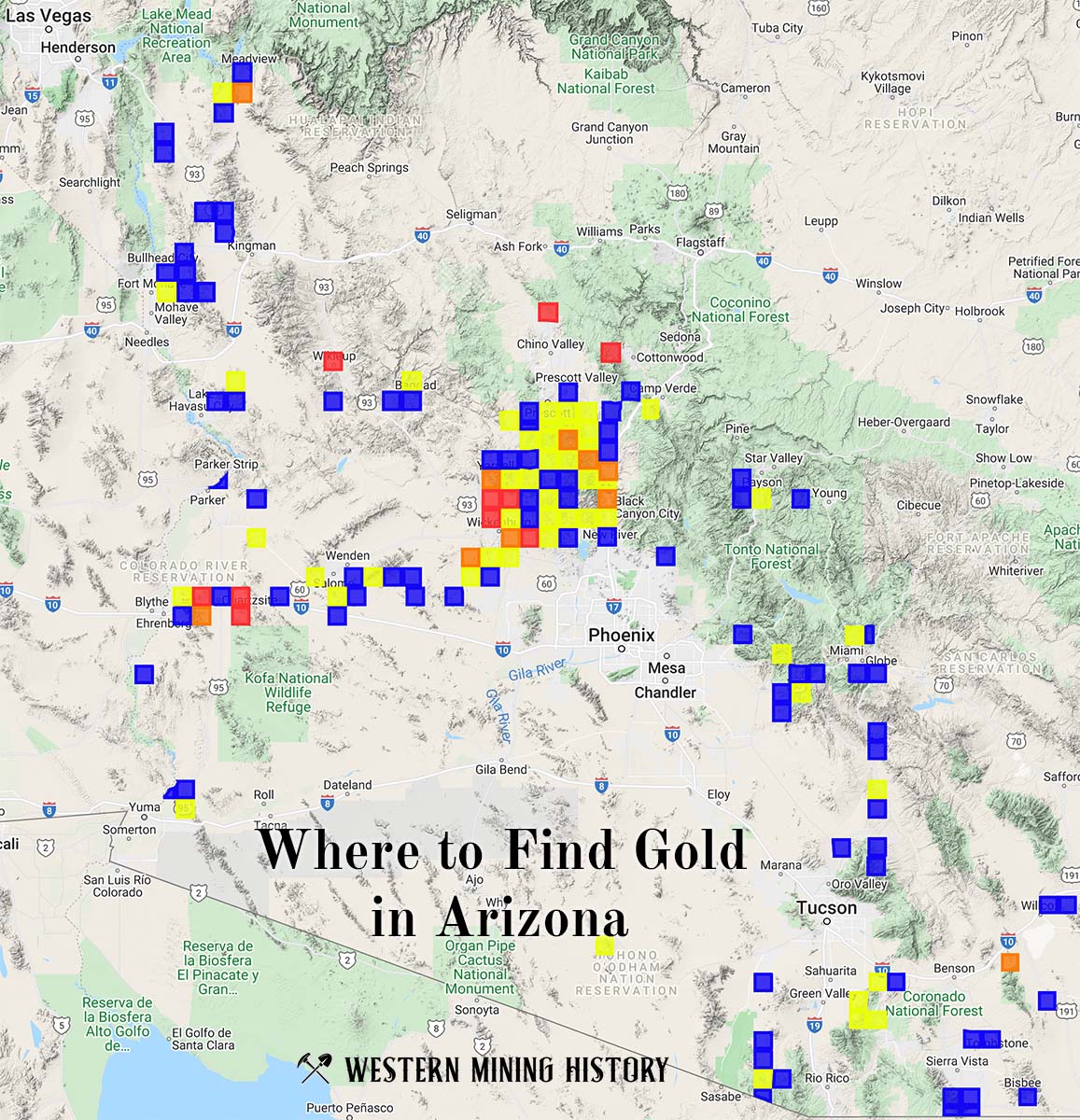The Richinbar Mine is a gold mine located in Yavapai county, Arizona at an elevation of 3,451 feet.
About the MRDS Data:
All mine locations were obtained from the USGS Mineral Resources Data System. The locations and other information in this database have not been verified for accuracy. It should be assumed that all mines are on private property.
Mine Info
Elevation: 3,451 Feet (1,052 Meters)
Commodity: Gold
Lat, Long: 34.20194, -112.10139
Map: View on Google Maps
Satelite View
MRDS mine locations are often very general, and in some cases are incorrect. Some mine remains have been covered or removed by modern industrial activity or by development of things like housing. The satellite view offers a quick glimpse as to whether the MRDS location corresponds to visible mine remains.
Mine Description
The Richinbar mine is at an altitude of 3,500 feet on the western brink of Agua Fria Canyon, about 4 miles east of Bumblebee and 9 miles by road from Cordes.
From about 1905 to 1908, the Richinbar Mines Company carried on extensive development work at this property, built a 20-stamp mill, and, according to local reports, mined some 8,000 tons of ore that contained about $6 per ton in gold together with a little silver. Lindgren(70) states that, prior to 1922, the mine was operated by three different companies and, in 1917, was unwatered and retimbered. Early in 1933, the Sterling Gold Mining Corporation obtained control of the property and, prior to May, 1934, made some surface improvements and carried on a little underground work. Eight men were employed.
Here, the Agua Fria River has carved a meandering canyon 1,000 feet deep through the mesa basalt and into the underlying pre-Cambrian complex of schist, diorite, and granite.
The mine is on a vein that strikes north, dips almost vertically westward, and occurs principally in schist. Its main or Zyke shaft is 500 feet deep and is reported to connect with several thousand feet of workings that extend northward. When visited in May, 1934, the workings below the 200-foot level were under water. The upper workings are reached by two other shafts north of the Zyke shaft.
As seen in the accessible workings, the gangue consists mainly of coarse, massive, glassy quartz with some tourmaline and carbonate. In the ore shoots, the quartz tends to be more or less cellular to platy. From the surface to the 200-foot level, the ore is mostly oxidized but locally contains pyrite, chalcopyrite, galena, and sphalerite. Most of the ore mined was from three irregularly lenticular vertical shoots. The largest stope seen, which is on the 140-foot level, was about 65 feet long by 55 feet high by 14 feet wide. Throughout its exposures, the vein pinches and swells abruptly.
The schist wall rock shows considerable sericitization and locally contains limonite pseudomorphs after pyrite. Lindgren regards the vein as pre-Cambrian in age.
(70) Work cited, p. 157.
Text from Arizona Lode Gold Mines and Gold Mining, Arizona Bureau of Mines. Original 1934, revised 1967
Richinbar Mine MRDS details
Site Name
Primary: Richinbar Mine
Commodity
Primary: Gold
Secondary: Silver
Secondary: Lead
Secondary: Copper
Location
State: Arizona
County: Yavapai
District: Richinbar District
Land Status
Not available
Holdings
Not available
Workings
Type: Underground
Ownership
Owner Name: Sterling Gold Mining Co.
Home Office: Cordes, Az.
Years: 1972 -
Production
Year: 1935
Description: Ap_Grade: ^8.34 Oz. Au/Ton, 1.92 Oz. Ag/Ton
Year: 1935
Material type: CONC
Description: Ap_Grade: ^6.4 Oz. Au, 1.3 Oz Ag, 0.7 % Pb, 0.2 % Cu
Deposit
Record Type: Site
Operation Category: Producer
Operation Type: Unknown
Year First Production: 1905
Year Last Production: 1948
Discovery Year: 1882
Discovery Method: Ore-Mineral In Place
Years of Production:
Organization:
Significant: N
Deposit Size: S
Physiography
General Physiographic Area: Intermontane Plateaus
Physiographic Province: Basin And Range Province
Physiographic Section: Mexican Highland
Mineral Deposit Model
Not available
Orebody
Form: LENTICULAR, PINCH AND SWELL, VERTICAL SHOOTS
Structure
Type: R
Description: Foliation In Precambrian Country Rock Trends N-S
Alterations
Not available
Rocks
Name: Mica Schist
Role: Host
Age Type: Host Rock Unit
Age in Years: 1750.000000+-
Dating Method: U-Pb (zircon)
Material Analyzed: Zircon
Age Young: Proterozoic
Name: Diorite
Role: Associated
Age Type: Associated Rock
Age Young: Neoproterozoic
Name: Diorite
Role: Associated
Age Type: Associated Rock Unit
Age Young: Neoproterozoic
Analytical Data
Not available
Materials
Ore: Galena
Ore: Sphalerite
Ore: Chalcopyrite
Ore: Pyrite
Gangue: Quartz
Comments
Comment (Development): 10 PATENTED CLAIMS
Comment (Workings): LEVELS DRIVEN FROM SHAFT RUN NORTH AND SOUTH AT 100 FOOT INTERVALS.
Comment (Geology): DEPOSIT IS VEIN OF QUARTZ AND PYRITE IN PROTEROZOIC BLAND QUARTZ DIORITE
Comment (Deposit): Discovery Year: EARLY 1880'S
References
Reference (Deposit): WILSON, E.D., 1934 , ARIZONA LODE GOLD MINES AND GOLD MINING: ARIZONA BUREAU OF MINES BULLETIN 137 , P. 54
Reference (Deposit): GUITERAS, J.R., 1936 , GOLD MINING AND MILLING IN THE BLACK CANYON AREA, YAVAPAI COUNTY, ARIZONA: U.S.B.M. INFORMATION CIRCULAR 6905 , P. 26
Reference (Deposit): ABGMT-USBM FILE DATA
Reference (Deposit): ABGMT CLIPPINGS FILE
Reference (Deposit): ARIZONA DEPT OF MINERAL RESOURCES FILE DATA
Reference (Production): U.S.B.M.I.C. 6905 , P. 28 ; U.S.G.S. BULL. 782 , P. 157
Reference (Deposit): USGS BULL 782, P. 157
Arizona Gold

"Where to Find Gold in Arizona" looks at the density of modern placer mining claims along with historical gold mining locations and mining district descriptions to determine areas of high gold discovery potential in Arizona. Read more: Where to Find Gold in Arizona.